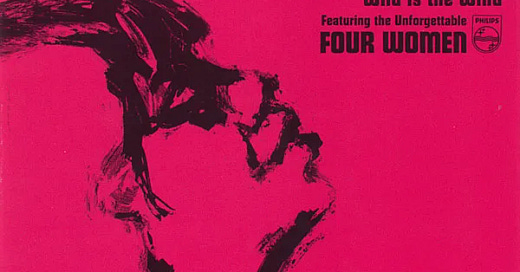Genre of the Day - Vocal Jazz
Album of the Day - Wild is the Wind by Nina Simone (1966)
March 27, 2024
Scat scat scat. Be bop be bop beeee bop. La da dee. On the surface jazz vocals and their improvisation-based nature seem so easy, because the greats make it look so easy. But scatting and singing over music as technically complex as jazz is a serious feat. It’s been around since the dawn of jazz itself, a sister to it rather than a descendent. Where there are clubs, there are club owners and promoters, so vocal jazz singers have always easily become stars in their own right, as important to the overarching nature of jazz as the instrumentalists.
While vocal jazz is less improvisational than instrumental jazz, it’s simply natural that an individual human voice ultimately has more limitations of range, sonic variation, and agility than the average instrument. But this shouldn’t demerit vocal jazz: to me astounding vocal acts are twice as impressive when able to meld to a jazz context, because there’s so much emphasis on mood and musical synergy and peculiar sonic dynamics. The great Louis Armstrong was the first to scat, imitating his masterful trumpet playing and forever changing the soundscape of jazz. It was women singers like Billie Holiday and earlier blues singers like Bessie Smith that elevated it from that improvisational, instrumental-imitating nature to emotional connection with the lyrics.
Because of this less improvisational nature, jazz as a genre and vocal jazz as a subgenre were divergent from the start. Once grounded with a proper understanding of vocal jazz, we can appreciate its intrinsic merits rather than the reductive notion that it is a “less musically creative” offshoot of jazz. Pop and jazz always walked hand in hand in the mid-20th century, as big band singers became the stars of the 1930s and 1940s. Nina Simone is a class totally her own, though. Artists deserve to be judged on their own vision of their art rather than our preconceived notion of them: NIna Simone never wanted to be relegated to the genres her work was often pigeonholed into. She was keenly aware of the way Black artists are pushed into the genres record labels and audiences see fit for them, and perpetually sought to push against those boundaries. She identified as a folk singer primarily, and outright rebuked the term jazz for her work in particular. However, there’s still elements of today’s album and a few of her other albums that are clearly jazz-adjacent instrumentally. Thus, while she may not be a jazz singer, she did sing jazz at certain points, and was one of the finest to do it.
Today’s album, Wild is the Wind, was recorded a few years into her recording career. Being that she’s noted as a singer-songwriter, I was surprised to see that she only penned one song on the album. However, it actually serves to highlight her multi-varied improvisational abilities. And the one song she did write stands out. The haunting “Four Women” is an exposé of America’s view of Black women, highlighting four stereotypes and colorism. Not only does it effectively harness her rage at the 1963 16th Street Baptist Church bombing, it provides an incisive take on colorism and the bitterness of racism across Black womanhood. While some write off vocal jazz, it has been one of the most important genres in birthing protest records that seize music’s potential to cry out. “Four Women” extends that tradition of ground-shaking songs like “Strange Fruit.” Elsewhere, she’s more tender. “What More Can I Say” features Simone as a crooner: the agility and beautiful vibrato of her unmistakable voice electrify single syllables over a song whose dramatism could overwhelm a less adept voice. On “Wild is The Wind” an intricate, Baroque melody moves like leaves rustling in the cool breeze of her dark voice. Another essential track is “Black Is The Color Of My True Love’s Hair.” over the chilly, mysterious standard, the music is stripped back to just her and her piano, featuring her at her most intimate. Vocal jazz is a kaleidoscope in Simone’s artistic hands, able to convey shades and colors that couldn’t be broadcast via a lesser medium. But also some good old scatting is well appreciated too, so I end as I begin: scat scat scat. Be bop be bop be bop.




